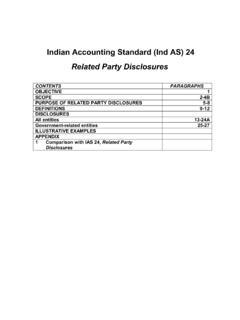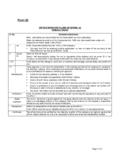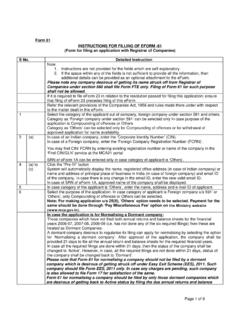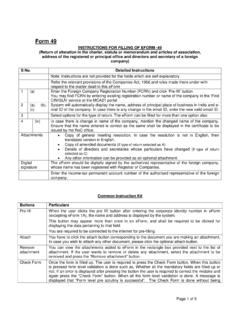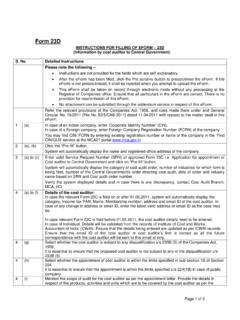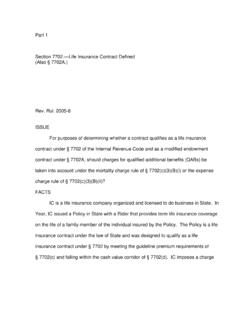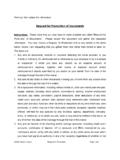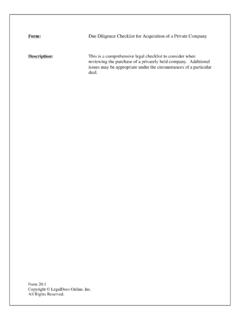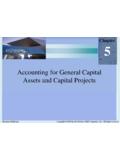Transcription of Indian Accounting Standard (Ind AS) 115, Revenue from ...
1 Indian Accounting Standard (Ind AS) 115, Revenue from Contracts with Customers (The Indian Accounting Standard includes paragraphs set in bold type and plain type, which have equal authority. Paragraphs in bold type indicate the main principles. Objective 1 The objective of this Standard is to establish the principles that an entity shall apply to report useful information to users of financial statements about the nature, amount, timing and uncertainty of Revenue and cash flows arising from a contract with a customer. Meeting the objective 2 To meet the objective in paragraph 1, the core principle of this Standard is that an entity shall recognise Revenue to depict the transfer of promised goods or services to customers in an amount that reflects the consideration to which the entity expects to be entitled in exchange for those goods or services.)
2 3 An entity shall consider the terms of the contract and all relevant facts and circumstances when applying this Standard . An entity shall apply this Standard , including the use of any practical expedients, consistently to contracts with similar characteristics and in similar circumstances. 4 This Standard specifies the Accounting for an individual contract with a customer. However, as a practical expedient, an entity may apply this Standard to a portfolio of contracts (or performance obligations) with similar characteristics if the entity reasonably expects that the effects on the financial statements of applying this Standard to the portfolio would not differ materially from applying this Standard to the individual contracts (or performance obligations) within that portfolio.
3 When Accounting for a portfolio, an entity shall use estimates and assumptions that reflect the size and composition of the portfolio. Scope 5 An entity shall apply this Standard to all contracts with customers, except the following: (a) lease contracts within the scope of Ind AS 17, Leases;. (b) insurance contracts within the scope of Ind AS 104, Insurance Contracts;. 590. (c) financial instruments and other contractual rights or obligations within the scope of Ind AS 109, Financial Instruments, Ind AS 110, Consolidated Financial Statements, Ind AS 111, Joint Arrangements, Ind AS 27, Separate Financial Statements and Ind AS 28, Investments in Associates and Joint Ventures; and (d) non-monetary exchanges between entities in the same line of business to facilitate sales to customers or potential customers.
4 For example, this Standard would not apply to a contract between two oil companies that agree to an exchange of oil to fulfil demand from their customers in different specified locations on a timely basis. 6 An entity shall apply this Standard to a contract (other than a contract listed in paragraph 5) only if the counterparty to the contract is a customer. A customer is a party that has contracted with an entity to obtain goods or services that are an output of the entity's ordinary activities in exchange for consideration. A counterparty to the contract would not be a customer if, for example, the counterparty has contracted with the entity to participate in an activity or process in which the parties to the contract share in the risks and benefits that result from the activity or process (such as developing an asset in a collaboration arrangement) rather than to obtain the output of the entity's ordinary activities.
5 7 A contract with a customer may be partially within the scope of this Standard and partially within the scope of other Standards listed in paragraph 5. (a) If the other Standards specify how to separate and/or initially measure one or more parts of the contract , then an entity shall first apply the separation and/or measurement requirements in those Standards. An entity shall exclude from the transaction price the amount of the part (or parts) of the contract that are initially measured in accordance with other Standards and shall apply paragraphs 73 86 to allocate the amount of the transaction price that remains (if any) to each performance obligation within the scope of this Standard and to any other parts of the contract identified by paragraph 7(b).
6 (b) If the other Standards do not specify how to separate and/or initially measure one or more parts of the contract , then the entity shall apply this Standard to separate and/or initially measure the part (or parts) of the contract . 8 This Standard specifies the Accounting for the incremental costs of obtaining a contract with a customer and for the costs incurred to fulfil a contract with a customer if those costs are not within the scope of another Standard (see paragraphs 91 104). An entity shall apply those paragraphs only to the costs incurred that relate to a contract with a customer (or part of that contract ) that is within the scope of this Standard .
7 591. Recognition Identifying the contract 9 An entity shall account for a contract with a customer that is within the scope of this Standard only when all of the following criteria are met: (a) the parties to the contract have approved the contract (in writing, orally or in accordance with other customary business practices) and are committed to perform their respective obligations;. (b) the entity can identify each party's rights regarding the goods or services to be transferred;. (c) the entity can identify the payment terms for the goods or services to be transferred;. (d) the contract has commercial substance (ie the risk, timing or amount of the entity's future cash flows is expected to change as a result of the contract ).
8 And (e) it is probable that the entity will collect the consideration to which it will be entitled in exchange for the goods or services that will be transferred to the customer. In evaluating whether collectability of an amount of consideration is probable, an entity shall consider only the customer's ability and intention to pay that amount of consideration when it is due. The amount of consideration to which the entity will be entitled may be less than the price stated in the contract if the consideration is variable because the entity may offer the customer a price concession (see paragraph 52). 10 A contract is an agreement between two or more parties that creates enforceable rights and obligations.
9 Enforceability of the rights and obligations in a contract is a matter of law. Contracts can be written, oral or implied by an entity's customary business practices. The practices and processes for establishing contracts with customers vary across legal jurisdictions, industries and entities. In addition, they may vary within an entity (for example, they may depend on the class of customer or the nature of the promised goods or services). An entity shall consider those practices and processes in determining whether and when an agreement with a customer creates enforceable rights and obligations. 11 Some contracts with customers may have no fixed duration and can be terminated or modified by either party at any time.
10 Other contracts may automatically renew on a periodic basis that is specified in the contract . An entity shall apply this Standard to the duration of the contract (ie the contractual period) in which the parties to the contract have present enforceable rights and obligations. 592. 12 For the purpose of applying this Standard , a contract does not exist if each party to the contract has the unilateral enforceable right to terminate a wholly unperformed contract without compensating the other party (or parties). A contract is wholly unperformed if both of the following criteria are met: (a) the entity has not yet transferred any promised goods or services to the customer.
